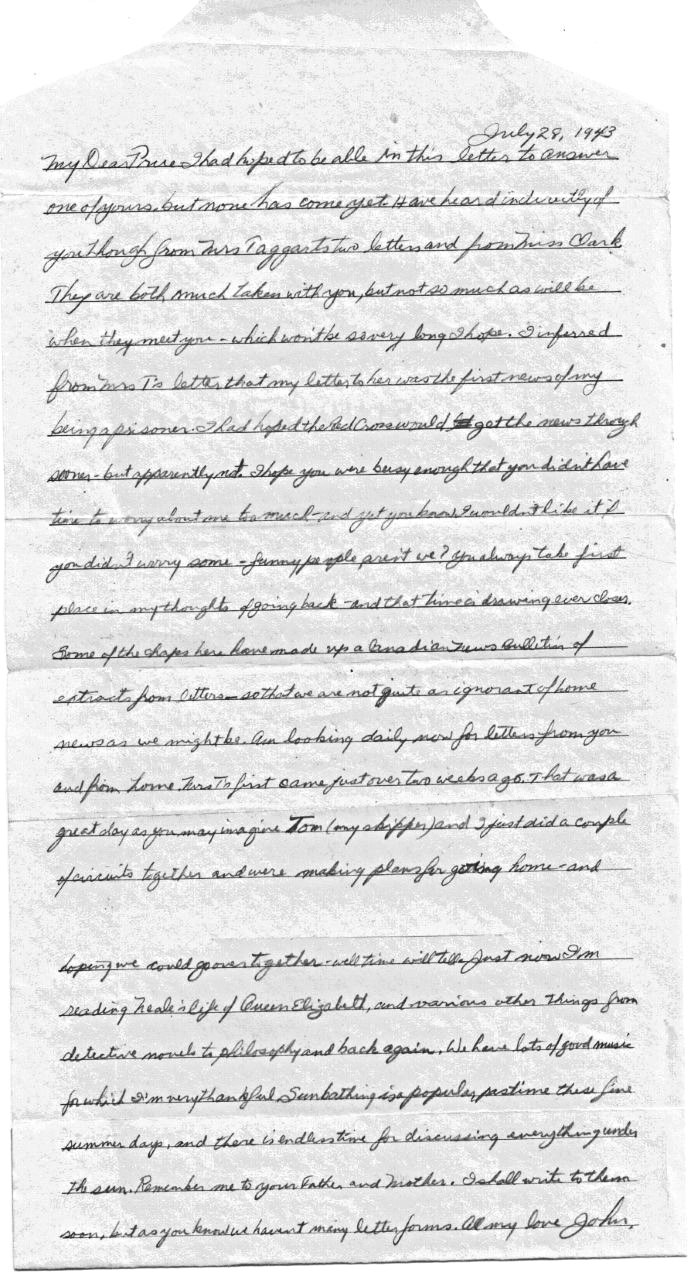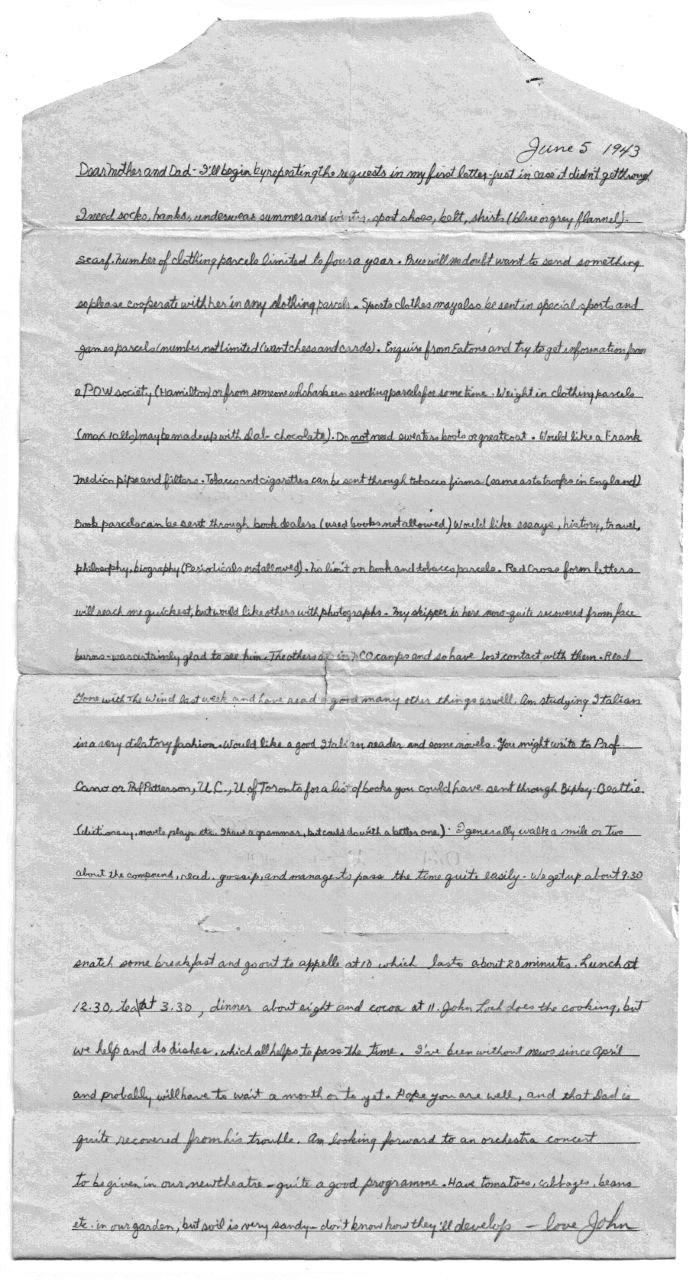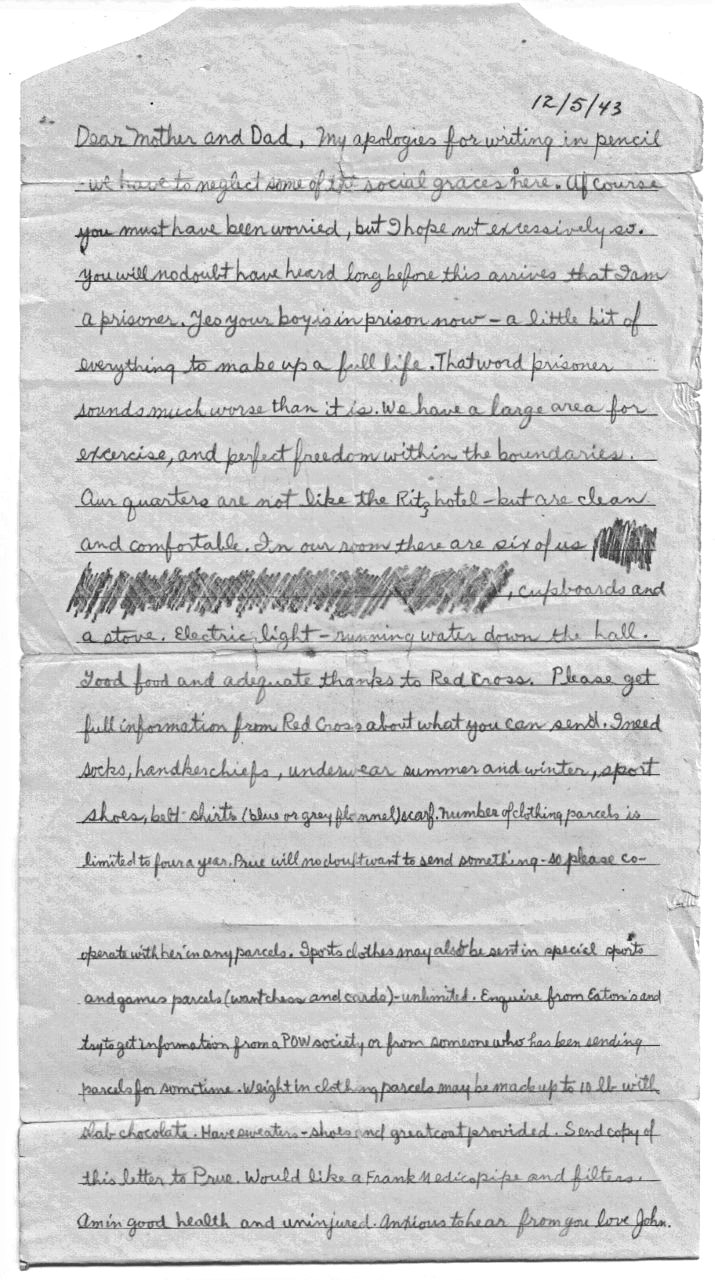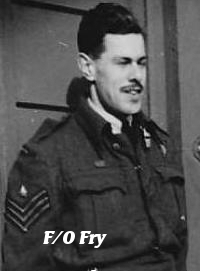John Fry grew up on a farm near Vineland, in the Niagara Peninsula area of Ontario and graduated from the
University of Toronto in modern languages in 1939.
With his enlistment in the Royal Canadian Air Force, John was first in the Fry family to ever serve in a war. The Fry family came from a Mennonite background and settled in the Vineland area in 1800 along with many others who came to Canada from Pennsylvania during the American War of Independence and the years following. Canada, still being under British rule, assured them religious freedom and exemption from military service.
He trained in Manitoba at No.7 Air Observer School in Portage la Prairie and Rivers. Followed by No.3 Bomb & Gunnery School
With the rank of Sergeant he was posted to 419 Squadron in January of 1942 his operational sortie was on October 13th. as Bomb Aimer for Sgt. Tom Jackson.
 For his new squadron it was a time of building and moving first from bases at Topcliffe, and then
stationed at Croft and finally the base which was to become Moose Squadrons permanent home, Middleton St. George
in Yorkshire.
For his new squadron it was a time of building and moving first from bases at Topcliffe, and then
stationed at Croft and finally the base which was to become Moose Squadrons permanent home, Middleton St. George
in Yorkshire.
The Squadron moved on to the new heavy bomber the Halifax in the beginning of 1943. The Jackson crew grew by two new members. Sergeants, Carlton, Crandell and Stortz now had Sgt. Jury as Air Gunner and Sgt. Sebastian as the Flight Engineer. The additional aircrew were needed for these larger "heavies"
Sgt. Fry's first operation on the Halifax was on January 15th 1943 to Lorient. The crew flew a number of sorties from January to until the night of April 20th. On that night of the 20th the target was Stettin, now Szczecin in northwest Poland.
They were attacked on the return flight over the Baltic Sea and came down near Eggesin in northeast Germany. John and two other members of the crew were not apprehended until three days later. They told the story that John's fluency in the German language and knowledge of the culture saved all of them during an encounter in the first day or so after finding themselves on the loose in enemy territory.
All but one of that Halifax bomber crew survived the war. The rear gunner was killed when they were shot down. John was imprisoned for two years in Stalag-Luft III, the prisoner of war camp where the events that later inspired the movie The Great Escape took place.
He owed his life to a silk parachute and became a member of the Caterpillar club, an organization supported by the Irving Parachute Company who gave a small gold caterpillar pin as a memento to everyone whose lives had been saved by one of their parachutes. The caterpillar is the silk worm and the back of the pin is engraved with "F/L J. R. Fry".
 John Fry and Prue Evans were married in Montreal on July 7, 1945. They had 2 sons and 3 daughters. John Fry passed away
January 6th 1997.
John Fry and Prue Evans were married in Montreal on July 7, 1945. They had 2 sons and 3 daughters. John Fry passed away
January 6th 1997.






With his enlistment in the Royal Canadian Air Force, John was first in the Fry family to ever serve in a war. The Fry family came from a Mennonite background and settled in the Vineland area in 1800 along with many others who came to Canada from Pennsylvania during the American War of Independence and the years following. Canada, still being under British rule, assured them religious freedom and exemption from military service.
He trained in Manitoba at No.7 Air Observer School in Portage la Prairie and Rivers. Followed by No.3 Bomb & Gunnery School
419 Squadron- Overseas
With the rank of Sergeant he was posted to 419 Squadron in January of 1942 his operational sortie was on October 13th. as Bomb Aimer for Sgt. Tom Jackson.
 For his new squadron it was a time of building and moving first from bases at Topcliffe, and then
stationed at Croft and finally the base which was to become Moose Squadrons permanent home, Middleton St. George
in Yorkshire.
For his new squadron it was a time of building and moving first from bases at Topcliffe, and then
stationed at Croft and finally the base which was to become Moose Squadrons permanent home, Middleton St. George
in Yorkshire. The Squadron moved on to the new heavy bomber the Halifax in the beginning of 1943. The Jackson crew grew by two new members. Sergeants, Carlton, Crandell and Stortz now had Sgt. Jury as Air Gunner and Sgt. Sebastian as the Flight Engineer. The additional aircrew were needed for these larger "heavies"
April 20/21 - Stettin
Sgt. Fry's first operation on the Halifax was on January 15th 1943 to Lorient. The crew flew a number of sorties from January to until the night of April 20th. On that night of the 20th the target was Stettin, now Szczecin in northwest Poland.
They were attacked on the return flight over the Baltic Sea and came down near Eggesin in northeast Germany. John and two other members of the crew were not apprehended until three days later. They told the story that John's fluency in the German language and knowledge of the culture saved all of them during an encounter in the first day or so after finding themselves on the loose in enemy territory.
All but one of that Halifax bomber crew survived the war. The rear gunner was killed when they were shot down. John was imprisoned for two years in Stalag-Luft III, the prisoner of war camp where the events that later inspired the movie The Great Escape took place.
He owed his life to a silk parachute and became a member of the Caterpillar club, an organization supported by the Irving Parachute Company who gave a small gold caterpillar pin as a memento to everyone whose lives had been saved by one of their parachutes. The caterpillar is the silk worm and the back of the pin is engraved with "F/L J. R. Fry".
 John Fry and Prue Evans were married in Montreal on July 7, 1945. They had 2 sons and 3 daughters. John Fry passed away
January 6th 1997.
John Fry and Prue Evans were married in Montreal on July 7, 1945. They had 2 sons and 3 daughters. John Fry passed away
January 6th 1997.






